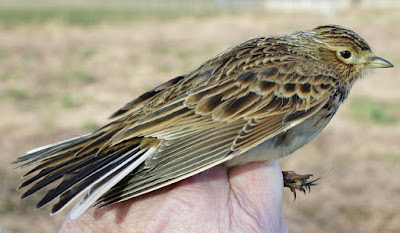Three a.m. and nature called. Later life has so many advantages but one or two drawbacks. With the alarm set for 0520 thoughts turned to the ringing session ahead and I knew that sleep would not return. At 0500 I switched the alarm off but took great care not to wake Sleeping Beauty.
Closer to destination Oakenclough interminable Long Lane rose to 700 above sea level as the black morning turned suddenly to gloomy hill mist and low cloud. Not exactly what the ringer ordered; Andy and I had missed another two and a half weeks of ringing due to unremitting wind and rain sweeping in from The Atlantic.
Our last visit had been on 6 November 2020. Nevertheless it felt good to be out again and where if the ringing was quiet, we could for sure put the world to rights via a cup of coffee, a natter and a few choice words.
The mist cleared, reappeared and then cleared again with barely a hint of the promised sun. What a strange sort of morning with few birds on the move save for a couple of flocks of Redwings, separate groups of fifteen and a forty, plus a few stragglers. Otherwise, 15-20 Chaffinch, a Kestrel gliding through the mist and the usual suspects at George’s bird feeders 30 yards away.
Just 10 birds caught - 3 Goldfinch, 3 Blue Tit, 2 Coal Tit and 2 Redwing. You can bet things are pretty quiet when a ringer posts a Blue Tit.
Blue Tit - Cyanistes caeruleus
Unlike recent weeks the weather looks fairly settled for a day or two so there may be chance to get some ringing and/or birding in. For tomorrow we have planned a visit to the Linnet catching site of recent years at Gulf Lane, Cockerham. We hope to clear an area of the now defunct crop to instead establish a whoosh netting area and bait it with a rape seed, niger and millet mix.
So far this autumn and winter there is no sign of a Linnet flock and despite a number of drop-in visits, the site has very few birds. Regular readers of this blog will know of our successes in previous years by establishing that many of the wintering Linnets in our local area originate from Scotland. Our total is 741 Linnet captures from 2016 to 2020.
Colder temperatures in January, February and March 2021 may see an influx of such individuals again and open up the possibility of catching other species like Chaffinch, Reed Bunting, Skylark and Stonechat.
We don’t succumb so easily to quiet days; they are part and parcel of a day in the great outdoors. What would we do otherwise? Watch daytime TV for a daily dose of brainwashing?
Linking today to Eileen's Blogspot and Anni's Birding.
















































































